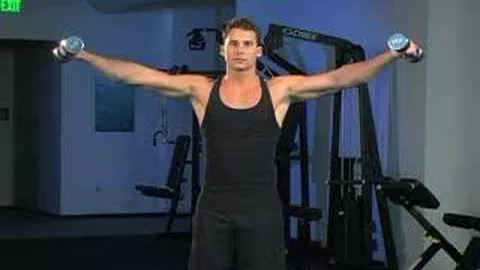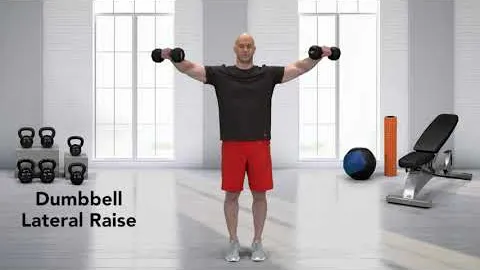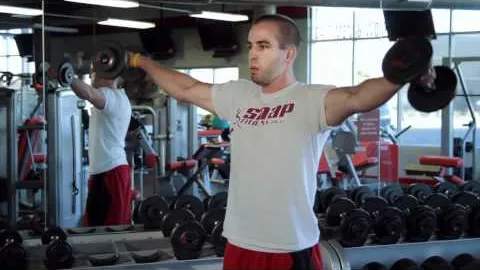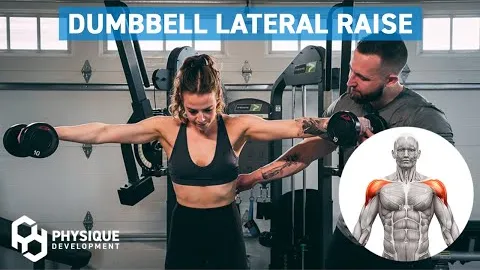




The dumbbell lateral raise is a highly effective exercise that targets the deltoid muscles, specifically the lateral deltoids. This exercise helps to build strength and definition in the shoulders, contributing to an overall balanced and well-developed upper body. In this guide, we will discuss the benefits of performing dumbbell lateral raises, proper form and technique, variations, and tips to maximize results.
Shoulder Muscle Development: The main benefit of performing dumbbell lateral raises is the targeted development of the lateral deltoid muscles. These muscles are responsible for the width and definition of the shoulders, giving them a rounded and athletic appearance.
Improved Shoulder Stability: Strong lateral deltoids contribute to overall shoulder stability, reducing the risk of injury during various upper body movements and exercises.
Enhanced Upper Body Symmetry: Including dumbbell lateral raises in your workout routine helps to create a balanced upper body by adding width to the shoulders, complementing the development of other muscle groups.
Increased Functional Strength: Strengthening the deltoids through lateral raises translates to improved performance in daily activities that require shoulder mobility and stability, such as lifting objects and performing overhead movements.
To maximize the benefits of dumbbell lateral raises and prevent injury, it is crucial to maintain proper form and technique. Follow these steps to perform the exercise correctly:
Starting Position: Stand with your feet shoulder-width apart, holding a dumbbell in each hand with a neutral grip. Allow your arms to hang naturally by your sides, palms facing your body.
Execution: Keeping a slight bend in your elbows, lift the dumbbells directly to your sides, ensuring that your arms are parallel to the floor. Avoid swinging your body or using momentum to lift the dumbbells. Focus on using your lateral deltoids to perform the movement.
Contraction: Hold the top position for a brief moment, feeling the contraction in your lateral deltoids. It is important to maintain control throughout the movement, avoiding jerky or rapid motions.
Lowering: Slowly lower the dumbbells back to the starting position, maintaining control and resisting the urge to let gravity take over.
Seated Dumbbell Lateral Raise: Performing the exercise while seated eliminates any momentum generated from the lower body, increasing the focus on the deltoids. Sit upright on a bench with your feet flat on the floor and follow the same steps as the standing variation.
Bent-Over Dumbbell Lateral Raise: This variation places more emphasis on the rear delts. Bend forward at the hips, keeping your back straight and parallel to the floor. Lift the dumbbells out to the sides, maintaining the same form as the standing lateral raise.
Choose the Right Weight: Select a weight that challenges you but still allows you to maintain proper form. Gradually increase the weight as you become stronger and more comfortable with the exercise.
Focus on Mind-Muscle Connection: Concentrate on engaging the lateral deltoids throughout the entire movement. Visualize the targeted muscles working and avoid relying on other muscle groups to lift the weights.
Control the Tempo: Slow and controlled movements provide greater muscle stimulation and prevent relying on momentum. Aim for a 2-3 second lift and a 2-3 second lowering phase.
Incorporate Progressive Overload: To continually see progress, gradually increase the weights or repetitions over time. Progressive overload challenges the muscles, promoting growth and strength gains.
Don't Neglect Warm-Up and Stretching: Before starting any workout, including dumbbell lateral raises, it is crucial to warm up the shoulder joints and surrounding muscles. Perform dynamic shoulder stretches and warm-up sets with lighter weights to prepare the muscles for the workload.
In conclusion, the dumbbell lateral raise is a highly effective exercise for strengthening the shoulders, particularly the lateral deltoids. By following proper form, incorporating variations, and implementing the provided tips, you can maximize the results and achieve well-rounded shoulder development. Remember to start with a weight that challenges you but allows for proper form, gradually increase the weights over time, and always listen to your body to avoid any potential injuries. Incorporate dumbbell lateral raises into your workout routine to build strong, stable, and aesthetically pleasing shoulders.
If you're looking for a gym, fitness club or yoga studio, you've come to the right place.
You can find information about gyms in your area. Browse catalog of gyms and find gyms with classes which are you looking for.
On gym page you can find simple information like address, phone or website. You can find list of available classes. You can check availability of personal training or small group classes. On place page you can also see information about open hours.
You can find gyms near you with amenities, courts, studios and equipments.
Use our map to find gym at your city or district.
In Gym Navigator you can find list of exercises with movies for many body parts.
You can browse exercises catalog and find exercises the best of you.
You can also find exercises grouped into workout plans, which you can use to improve you body. Each routine show you exercises one by one and give you possibility to count you progress and count down rest time.